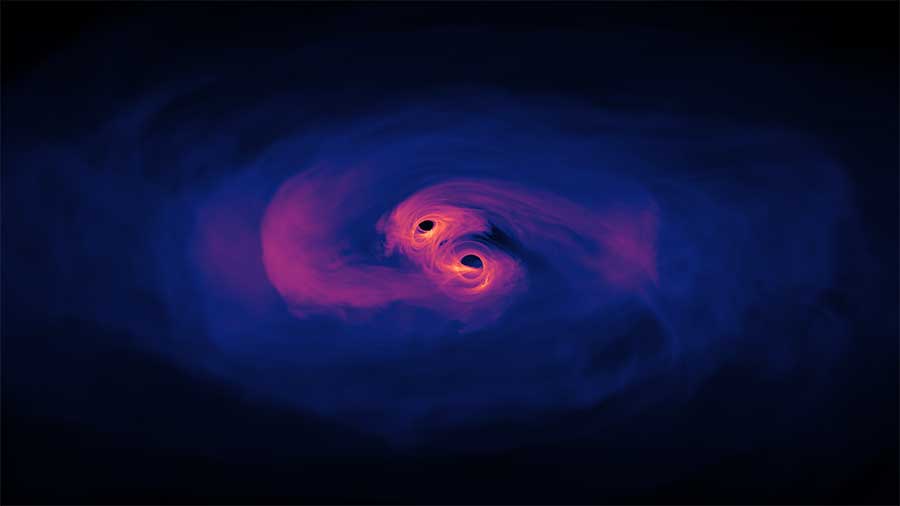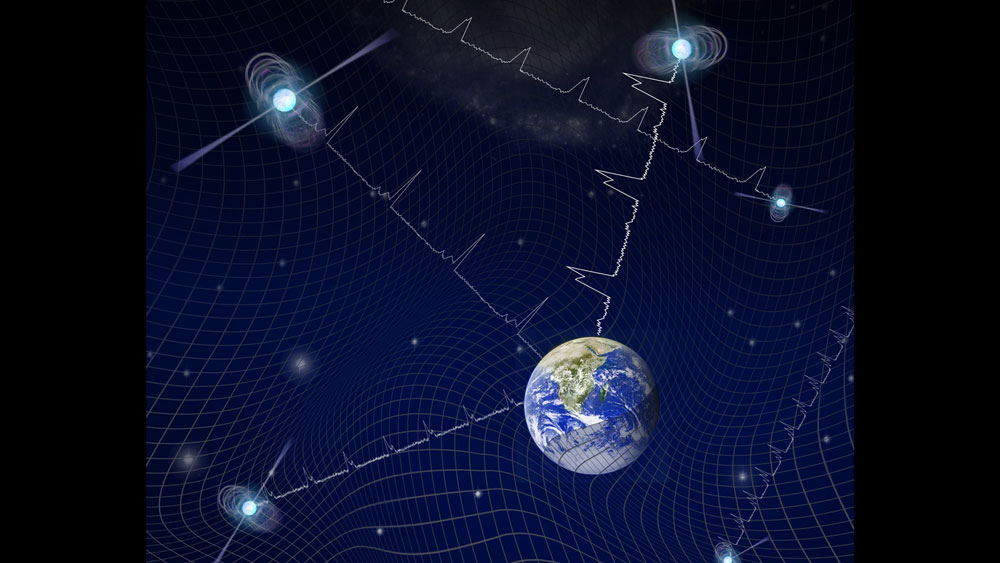Radio observatories across the globe have found compelling evidence for the existence of very-low-frequency gravitational waves.

NASA's Goddard Space Flight Center / Scott Noble
Radio observatories across the globe have found compelling evidence for the existence of very-low-frequency gravitational waves. These slow and minute undulations of spacetime are thought to be produced by supermassive black hole binaries in remote galaxies.
“After years of work, [we are] opening an entirely new window on the gravitational-wave universe”, says Stephen Taylor (Vanderbilt University), chair of the North American Nanohertz Observatory for Gravitational Waves (NANOGrav) collaboration.
More than a century ago, Albert Einstein predicted gravitational waves, but only in 2015 did the U.S. Laser Interferometry Gravitational-wave Observatory (LIGO) first detect them. Ever since, LIGO and similar detectors in Italy and Japan have found dozens of short, high-frequency gravitational-wave bursts, produced by collisions of stellar-mass black holes or compact neutron stars.
Ground-based detectors can only observe gravitational waves with frequencies on the order of a few thousand hertz (ripples per second). However, the universe is also expected to bathe in a sea of continuous nanohertz gravitational waves, with spacetime slightly expanding and contracting only once every couple of decades or so. According to a collection of papers published today by The Astrophysical Journal Letters, Astronomy & Astrophysics, Publications of the Astronomical Society of the Pacific, and Research in Astronomy and Astrophysics (see links to references below), this long-sought background signal is now finally emerging from high-precision radio observations.
“It’s as if LIGO can only hear the high pitch of a piccolo, while we listen to the low vibrations of a contrabass”, explains Gemma Janssen (ASTRON Netherlands Institute for Radio Astronomy). “To understand the whole symphony, you obviously need both.”
Indeed, the new observations “add another element in the spectrum,” adds David Shoemaker (MIT), a former spokesperson for LIGO who was not involved in the new study. “This is an enriching observation.”
A Galaxy-Size Detector

NANOGrav / T. Klein
While LIGO and its counterparts detect rapid, minuscule length variations in its kilometers-long detector arms due to passing high-frequency gravitational waves, the new observations in effect use the Milky Way Galaxy as their detector. Nanohertz gravitational waves from supermassive black hole pairs all over the universe continuously stretch and squeeze our home galaxy, albeit very slowly and minutely. In a two-dimensional analogy, it’s as if flat spacetime is turned into the rippling surface of a swimming pool.
By meticulously measuring the arrival times of radio pulses from dozens of millisecond pulsars all across the sky for decades on end, radio astronomers are now finally registering these slow spacetime ripples. “We’re using a gravitational-wave detector the size of the galaxy that’s made out of exotic stars, which just blows my mind,” says Scott Ransom (National Radio Astronomy Observatory).
Millisecond pulsars are rapidly spinning neutron stars — the super-compact remains of massive stars that went supernova. Like cosmic lighthouses on steroids, they sweep beams of radio waves through space. As a result, radio telescopes on Earth observe several hundreds of radio pulses per second, arriving with nanosecond regularity.

Northwestern University
Low-frequency gravitational waves vary the reliable pulse arrival times ever so slightly over time. These variations only gradually become apparent over the course of many years. “When I first saw [the evidence], I was awestruck”, says Maura McLaughlin (West Virginia University). “It was a magical moment. For the first time, we now have good evidence for the existence of nanohertz gravitational waves. It’s very difficult to explain [the observations] by any other process.”
McLaughlin is one of the codirectors of NANOGrav. This collaboration of almost 200 members at more than 70 institutions, funded by the National Science Foundation, combined observations of 68 millisecond pulsars carried out over the past 15 years by the 305-meter Arecibo Observatory in Puerto Rico, the 100-meter Green Bank Telescope in West Virginia, and the 27-element Very Large Array in New Mexico.
Likewise, the European Pulsar Timing Array (EPTA) collaboration combined data on 25 pulsars from the five largest European radio observatories at Jodrell Bank (United Kingdom), Effelsberg (Germany), Nançay (France), Sardinia (Italy), and Westerbork (the Netherlands). “We also teamed up with colleagues from India and Japan,” says Janssen, a member of the EPTA Steering Committee.
Both NANOGrav and EPTA report an “emerging” nanohertz gravitational-wave signal in their data. Data from similar projects carried out with the 64-meter Parkes radio telescope in Australia and with the Five hundred meter Aperture Spherical Telescope (FAST) in China, also published today, are consistent with the U.S. and European results.
“We just don’t obtain a flashy signal like LIGO does,” says Janssen. “Instead, it’s detection in slow-motion.”
Taylor agrees. “This isn’t something that happened overnight,” he says.
One Part in Quadrillion
The detection is at the limits of what is currently possible. Even without gravitational waves, pulse arrival times vary ever-so-slightly, due to the diurnal rotation and orbital motion of the Earth, the orbital motion of the pulsar (most millisecond pulsars are members of binary stars), the motion of both the pulsar and our solar system through the Milky Way galaxy, and the varying amount of interstellar electrons along the line of sight, including space weather effects in our own solar system. All these factors have to be accounted and compensated for.
Moreover, as NANOGrav member Michael Lam (SETI Institute) explained at a press conference, millisecond pulsars may be very stable rotators, but they’re not exactly perfect. “The signal we’re trying to measure is extremely tiny,” he says, “with an amplitude of one part in a quadrillion.” According to Lam, that’s less than the average natural variation in the behavior of typical millisecond pulsars.
The only way to detect the very subtle gravitational-wave signal is by statistically studying the timing measurements for dozens of pulsars all over the sky over many years, and looking for expected correlation patterns in their behavior, which in turn depends on their position relative to one another on the sky. Observations of pulsars in similar regions on the sky should exhibit similar variations, while pulsars separated by 90 degrees on the sky should behave “out of sync.” The results obtained so far neatly match the predictions from Einstein’s theory of general relativity. According to Lam, there’s only a one in 1,000 likelihood that the observed correlation patterns are due to chance. (That corresponds to a better than 3 sigma significance.)
By carrying out a combined analysis of the various pulsar timing array projects, the results will continue to increase in statistical significance over the next one or two years, hopefully reaching the 5-sigma level (a one in 3.5 million chance of the signal being a fluke) that's required to claim a real discovery. “This is not an easy job,” notes McLaughlin. “Combining all the data is a very difficult process.”
Moreover, observations will continue for many years to come, with newly discovered millisecond pulsars added to the roster on a regular basis. As Taylor says, “We need more time, and more pulsars.”
Finding the Culprits
It’s not yet possible to identify individual sources of nanohertz gravitational waves. In the swimming pool analogy: It’s clear that the water surface is somehow disturbed, but from the observed ripples, you can’t conclude how many swimmers there are in the pool, let alone where they are located. But in the future, that may change, too. Who knows, this may even happen by combining the data from the various projects that work together in the International Pulsar Timing Array collaboration (IPTA).
If the tardy ripples are indeed produced by countless orbiting supermassive black hole binaries, we might eventually be able to identify them, says theoretical astrophysicist and EPTA member Alberto Sesana (University of Milan, Italy). “The observed signal may well be dominated by just a handful of relatively nearby systems,” he explains. “Right now, the evidence is inconclusive, but within a few years, we hope to get a better handle on this.”
But even now, Sesana adds, the results provide important insights into the evolution of galaxies. When two galaxies collide, each with their own supermassive black hole weighing in at hundreds of millions or even billions of solar masses, the two black holes will eventually start to orbit each other. To produce nanohertz gravitational waves, though, they need to get close enough (within a few light-years at most) to eventually coalesce into an even more massive monster.
“This is not trivial”, Sesana says. “It’s the first time we’ve confirmed that supermassive black holes do indeed merge in nature.” That’s important because it’s a popular scenario to explain the existence of billion-solar-mass heavyweights in the nuclei of some galaxies.
Interestingly, the amplitude of the observed low-frequency ripples is higher than most theoretical models had predicted. This might indicate that supermassive black hole binaries are more abundant in the universe, or that they are more massive than expected, or both. Another remote possibility is that the nanohertz waves are not produced only by supermassive black hole binaries, but also by cosmic strings — weird topological defects in the very structure of spacetime — or other strange phenomena dating back to the very early universe.
Future Prospects
Unfortunately, the venerable 14-dish Westerbork Synthesis Radio Telescope in the Netherlands, which contributed significantly to the EPTA results, is no longer available for pulsar timing measurements, according to Janssen. As for NANOGrav, the collapse of the Arecibo dish in December 2020 meant a huge loss in the program’s sensitivity. “We definitely need a new large radio telescope in the USA”, says McLaughlin.
The Deep Synoptic Array-2000, a huge collection of 2,048 small radio dishes to be built in Nevada, may fit that bill. Meanwhile, the Canadian Hydrogen Intensity Mapping Experiment (CHIME) joined the NANOGrav instrument suite in 2019.
Despite these setbacks, the new field of nanohertz gravitational waves is likely to explode in the near future. China’s FAST telescope, which only started observations in 2016, will keep adding extremely sensitive pulsar timing measurements for many years to come. The same is true for the 64-element MeerKAT array in South Africa. And before the end of the decade, the mid-frequency part of the giant Square Kilometer Array, which will incorporate MeerKAT, will become the most powerful observatory for these kinds of measurements.
Eventually, gravitational waves will provide astronomers with a fascinating window on the properties and evolution of a wide variety of otherwise invisible black holes, from relatively low-mass coalescing systems studied by ground-based detectors to the in-spiraling behemoths uncovered by millisecond pulsar observations. As LIGO’s Shoemaker comments: “This is a very positive development. We are now able to study these astrophysical processes at completely different scales.”
References:
European Pulsar Timing Array: Data Release 2
Parkes Pulsar Timing Array: Data Release 3 — Paper 1, Paper 2, Paper 3
Chinese Pulsar Timing Array: Data Release 1
Sky & Telescope contributing editor Govert Schilling is the author of Ripples in Spacetime (Harvard University Press, 2017).
 0
0









Comments
You must be logged in to post a comment.